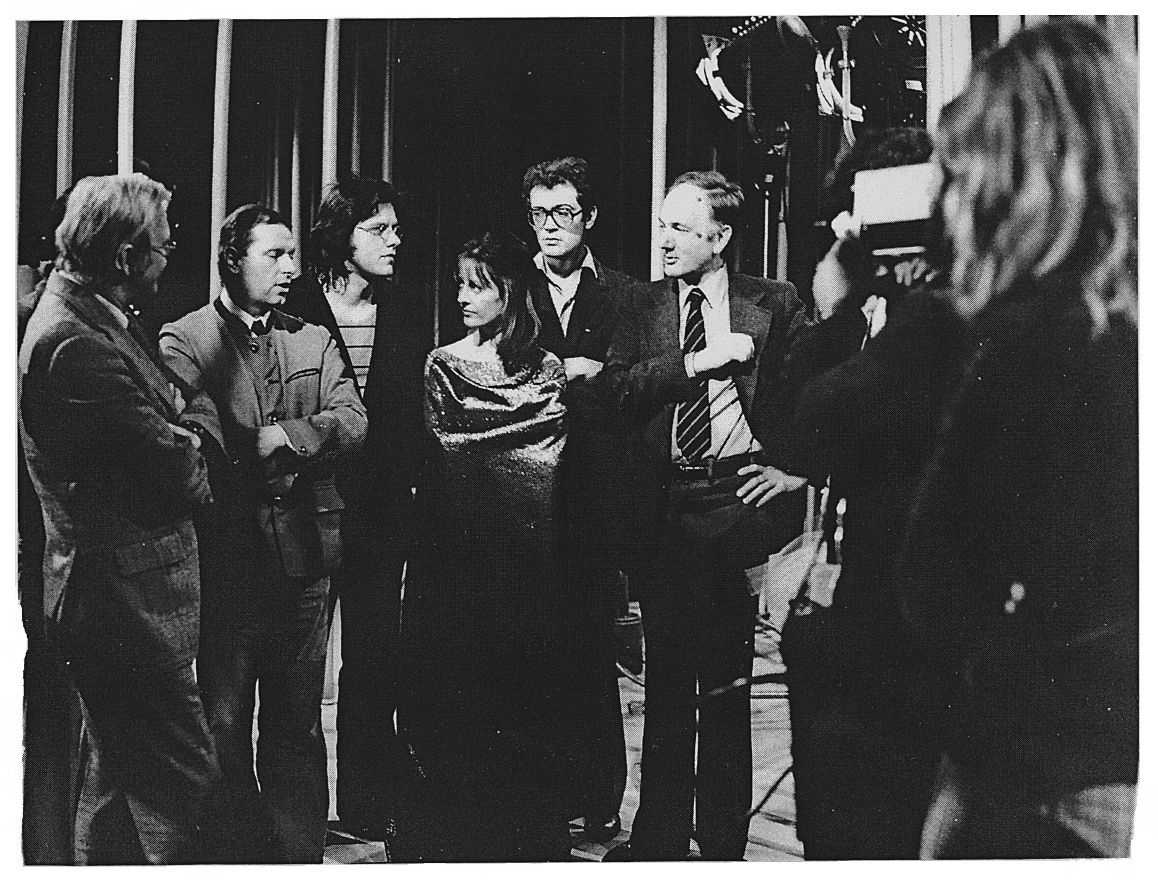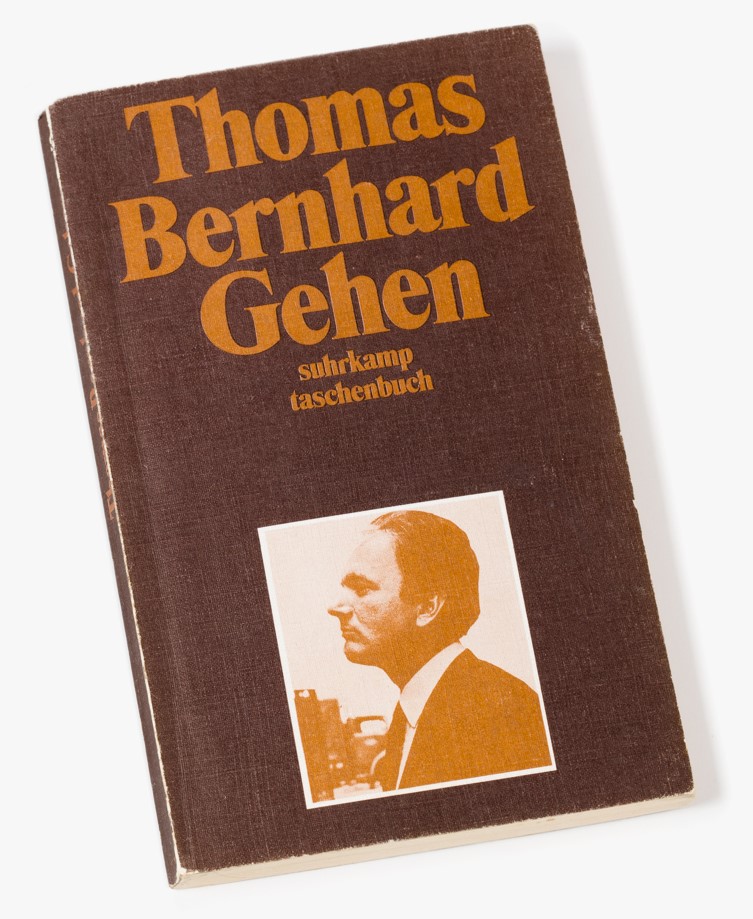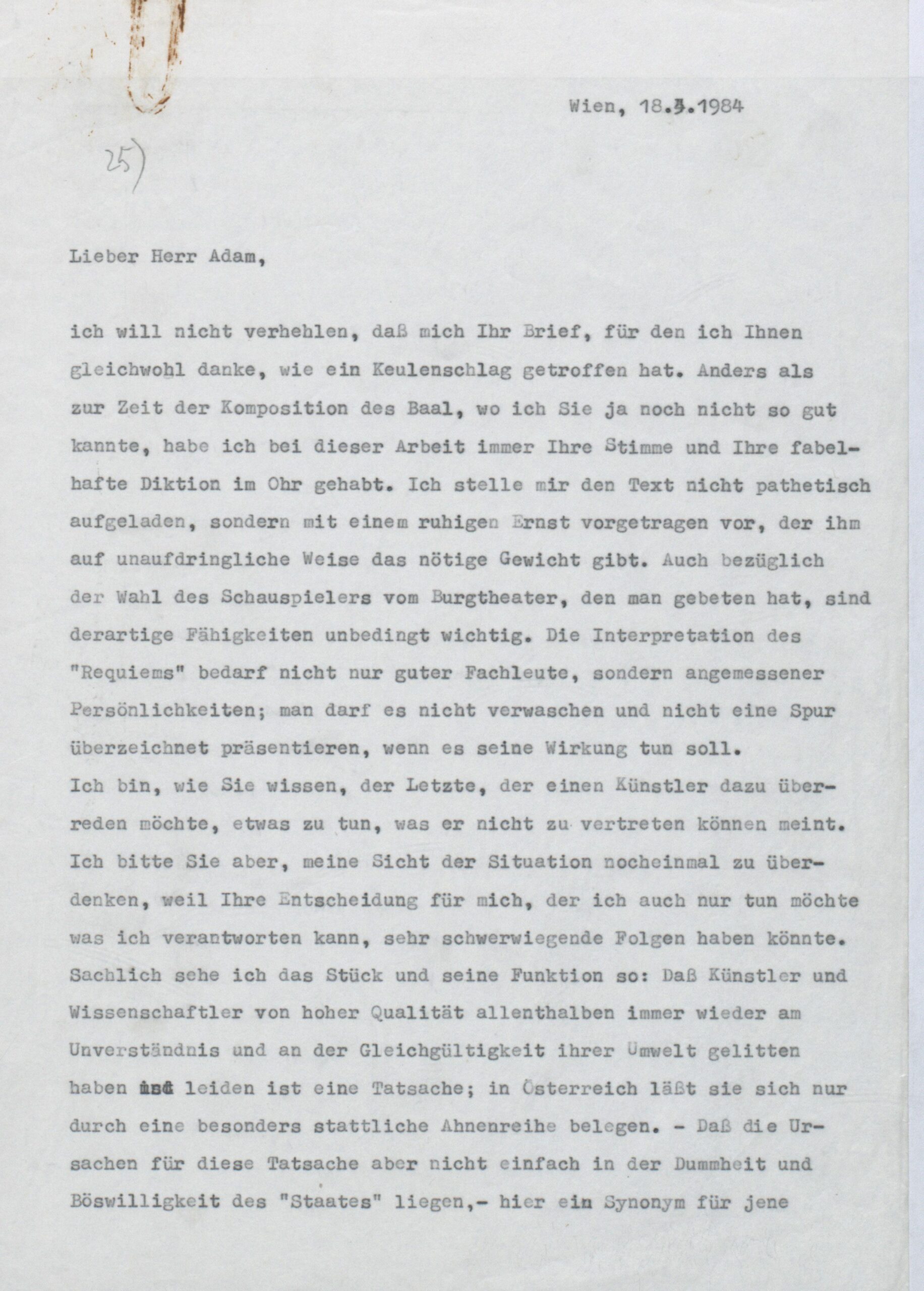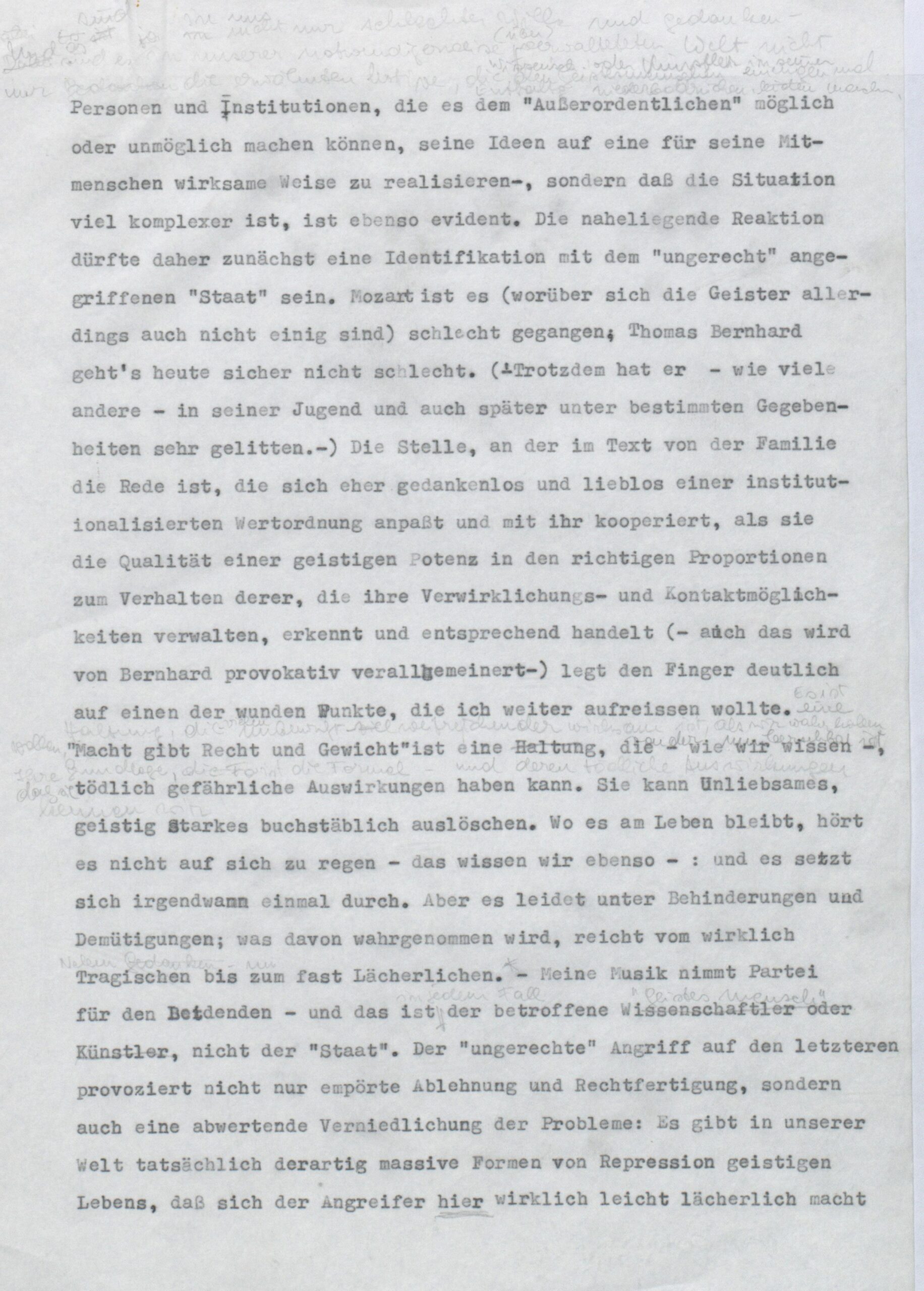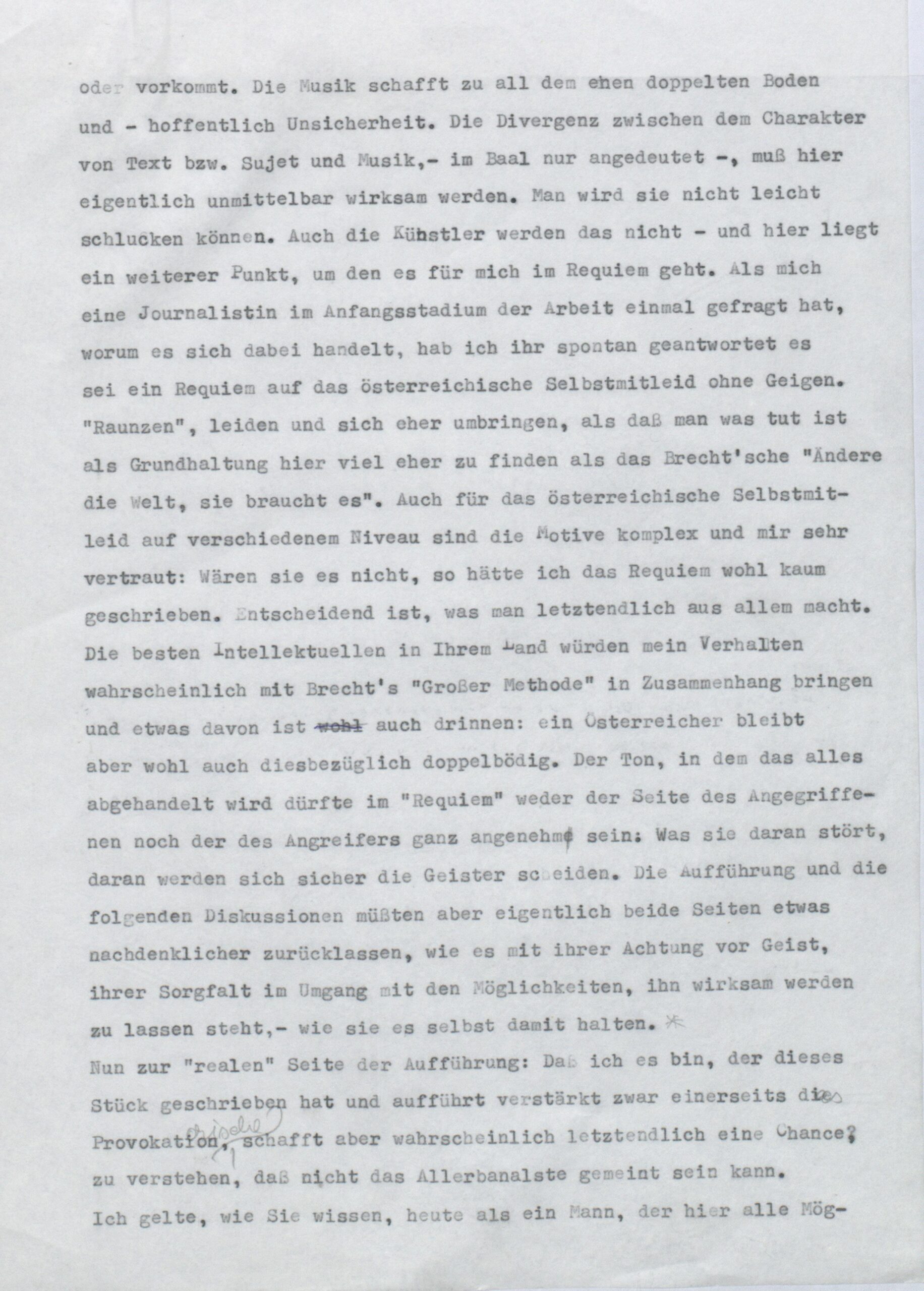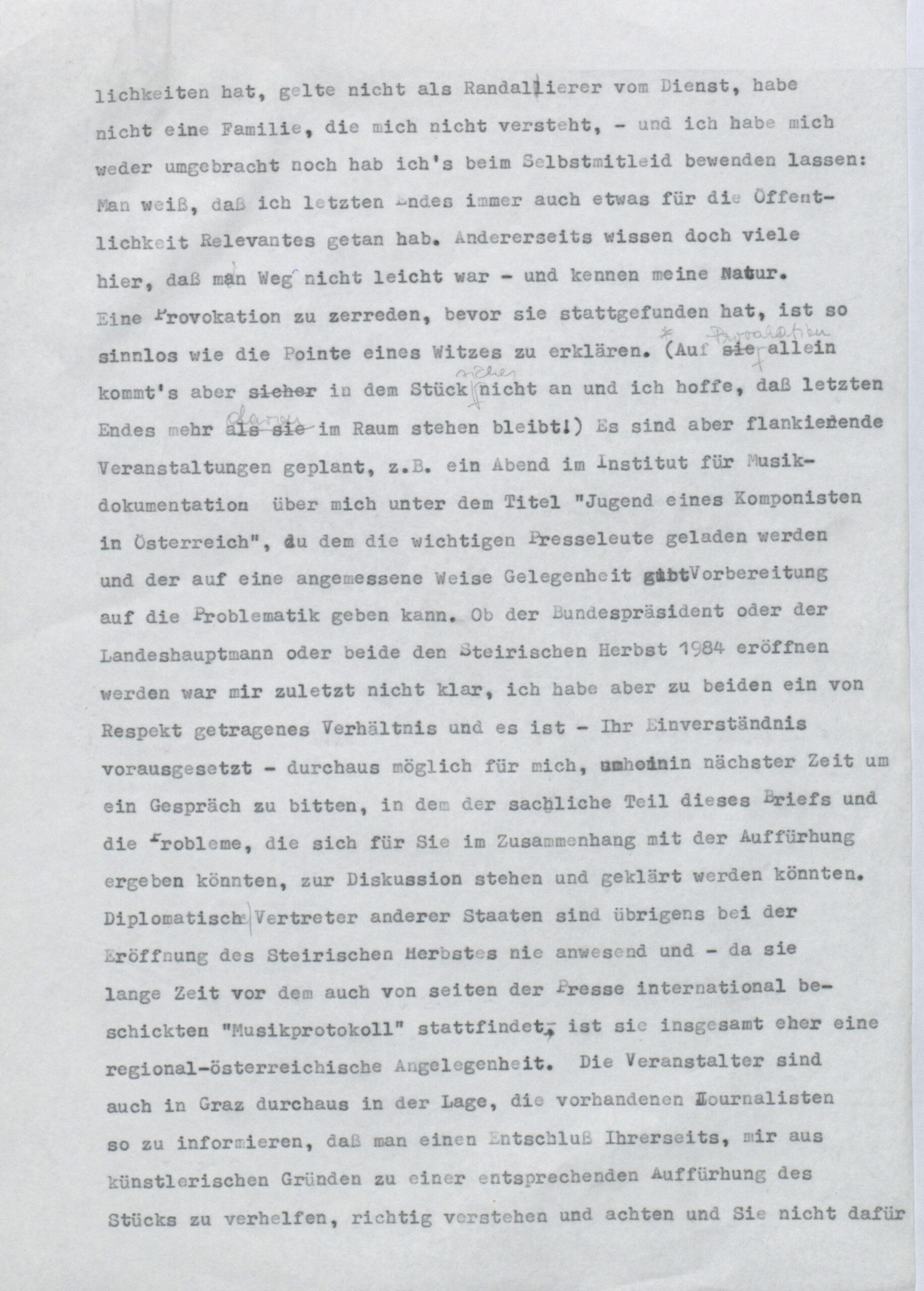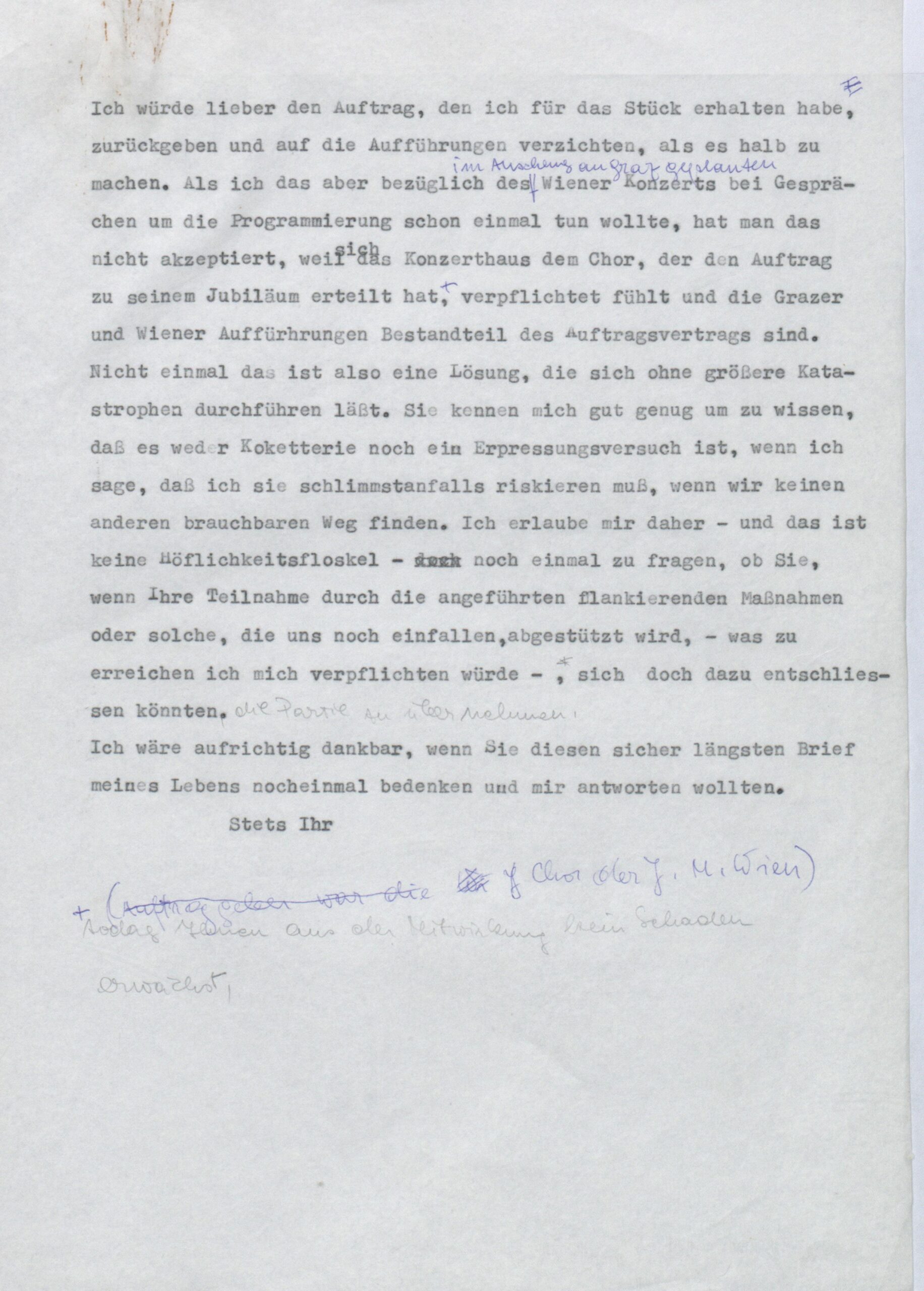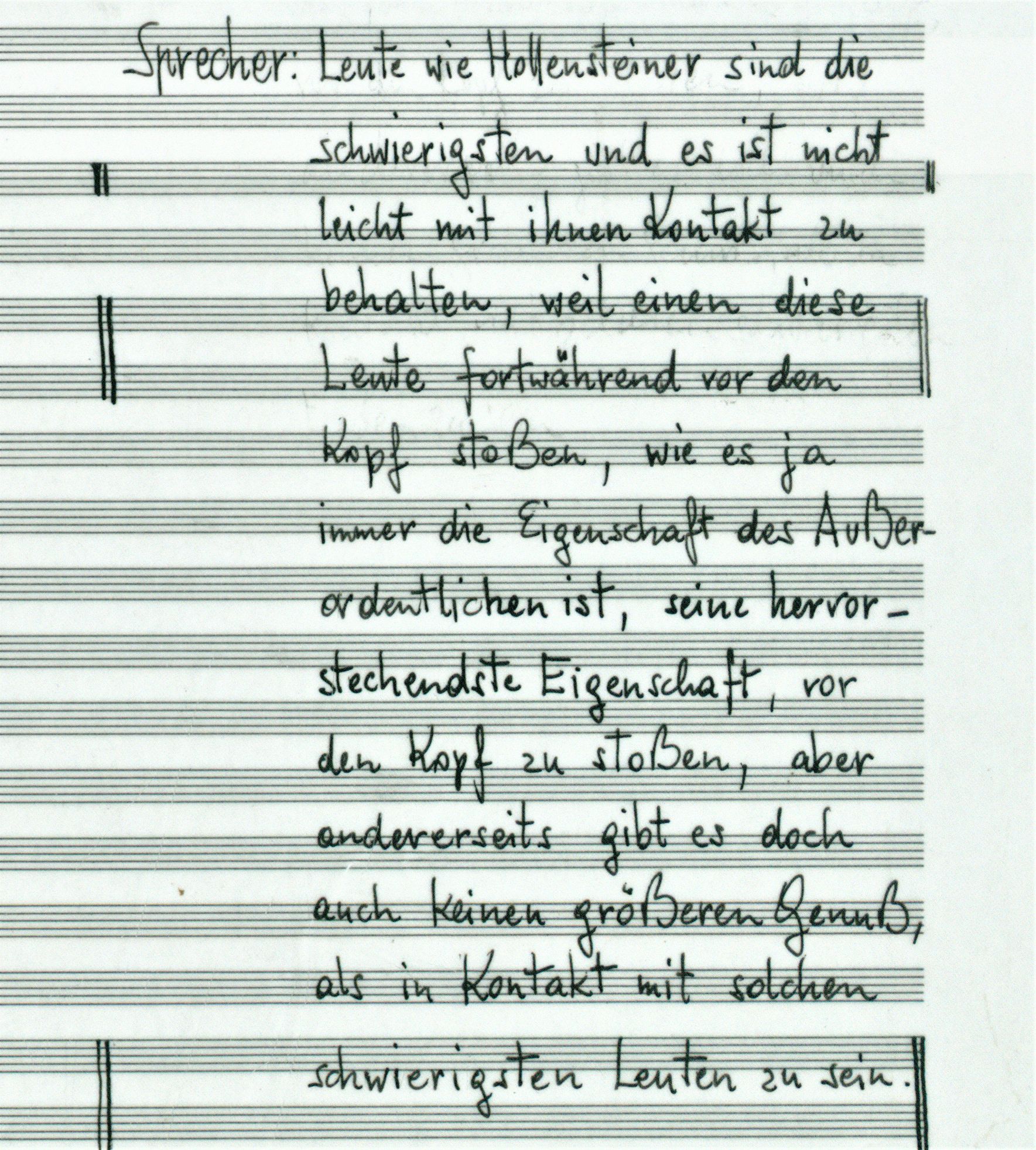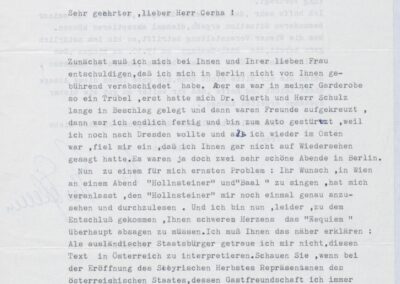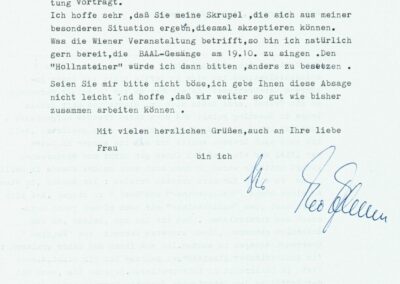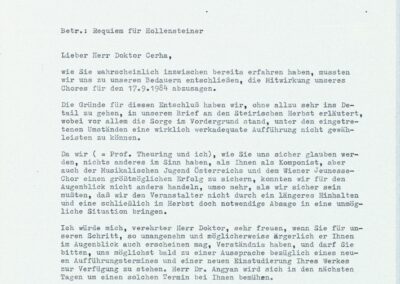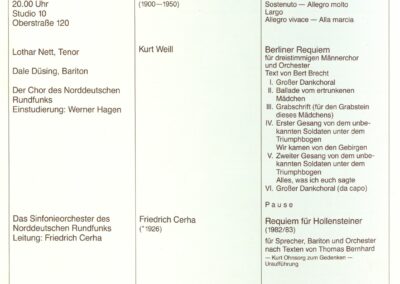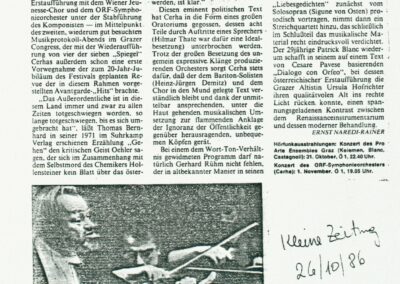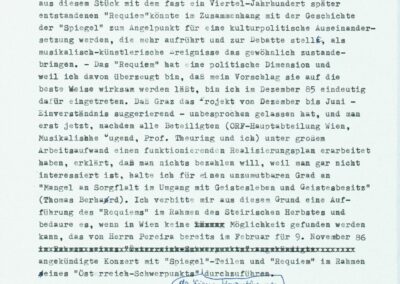Requiem for Hollensteiner
“The Genius Is Abandoned”
Der Riese vom Steinfeld
Baal
Georges Seurat, Two Men Walking in a Field, ca. 1882-1884
The drawing by French artist Georges Seurat shows two men taking a walk—also the premise for Thomas Bernhard’s story Gehen, upon which Cerha’s Requiem für Hollensteiner is based. As in Seurat’s portrayal, walking (and the thinking that often accompanies it) leads through dark realms in Bernhard’s novella.
Points of contact in front of the camera:
The following snapshot was taken behind the scenes of a television studio around 1960.
The picture shows writer Thomas Bernhard with several musicians from the newly founded “die reihe” ensemble. The reason for this meeting was the television recording of an opera performance of die köpfe by composer Gerhard Lampersberg. Bernhard wrote the play’s libretto. Unfortunately, Cerha is not visible in the photo—in fact, there is not a single picture of him with Bernhard, although the two often met and were friendly. Cerha must have been in the television studio at the time, as he was conducting his friend Lampersberg’s work, one of the earliest Bernhard settings. Much later, Cerha also ventured to put a Bernhard text to music: his Requiem für Hollensteiner.
Außenansicht
After WWII, the cultural offerings in Vienna were rather sparse. Young artists had little opportunity to present themselves and their works to the public, and had to establish their own platforms. The Art Club, founded in 1946, was probably the most important forum for this. Artists met in cafés, bars, and art studios, as did Cerha and Bernhard—although their paths had probably not yet crossed at that point. There was a merging of the disciplines in the early post-war years, with music, literature, fine arts, and sculpture all influencing each other. Since “Modernism” was largely banned from public life, it was all the more important to broaden one’s personal field of vision.
Centres for young artists also formed outside of Vienna. One of these was the Tonhof, which established itself in Maria Saal, a small village in Carinthia. The farming estate was owned by Gerhard Lampersberg and his wife, Maja. Starting in the mid-1950s, they regularly invited colleagues to their home. One of the first guests was Bernhard, whom the couple had met at Art Club events. He quickly formed a deep friendship with the Lampersbergs, and the crowd of artists soon grew. After about 1960, the Tonhof became known as a summer residence: Writers Peter Handke and Josef Winkler, painter Fritz Riedl, and actress Bibiana Zeller were just as much a part of it as a large number of composers, including Gerhard Rühm, Anestis Logothetis, Iván Eröd, and Otto M. Zykan. Cerha also turned up at the Tonhof. It was here, at the latest, that he got to know Bernhard personally.See Schriften: ein Netzwerk, Vienna 2001, p. 27 This is also where Cerha conducted Lampersberg’s piece die köpfe for the first time—in the barn. After this, Cerha’s and Bernhard’s paths went in different directions, although they never lost sight of each other entirely. About 20 years later, in 1982, Cerha visited Bernhard on “his farm in Obernathal to obtain his consent” for setting one of his writings to music.Manfred Mittermayer, “Eine Musik des Getrieben-Seins – Friedrich Cerha und Thomas Bernhard”, in: Matthias Henke and Gerhard Gensch (eds.): Mechanismen der Macht. Friedrich Cerha und sein musikdramatisches Werk, Innsbruck 2016, pp. 181–197, here p. 190 Bernhard liked the title Requiem for Hollensteiner very much and, after skimming the libretto, gave his permission.
Brücke
Bernhard’s prose, now part of the canon, is political language art. “Political”, not in the sense of ideological plans for the world, but in its relentless identification of things that are wrong. Many of his novels and short stories stand up against aspects of Austrian life. Bernhard attacks the philistinism, double standards, and hostility to art, attempting to dissolve it with caustic, ironic criticism. The literary, sophisticated polemics of his writings caused a massive headwind, not only from state cultural institutions and the Viennese press, but also from individuals who saw themselves in the sometimes pitch-black descriptions. Lampersberg was one of these when Bernhard published his novel The Woodcutters in 1984, a hateful yet artful tirade against the Tonhof and its protagonists. The end of the novel formed the basis for Cerha’s second Bernhard setting: the expansive orchestral song “Bevor es zu spät ist” (1988/97), which was composed a few years after Requiem für Hollensteiner. In both cases, Bernhard’s criticism of Austria as being terrain hostile to art contributed to Cerha’s interest. In the 1950s, both Cerha and Bernhard likely experienced being pushed away by conservative Vienna, bringing their biographical horizons closer together. For example, Cerha describes how he felt while reading The Woodcutters, saying he “vividly recalled the nights” when he “like the narrator of the novel—walked through [his] town that [he] hated and yet knew that [he] was chained to it with a thousand shackles and could not live anywhere else for long.“Schriften: ein Netzwerk, Wien 2001, S. 277
The contradiction between the government-created obstacles that were simultaneously necessary for survival also lies at the heart of Requiem für Hollensteiner. The play is based on Bernhard’s 1971 story Gehen, an experimental, linguistically virtuosic piece of writing. Its content can be summarised in just a few sentences: The nameless narrator tells of recent events in his life. Two other central figures are his friends Oehler and Karrer, and all three are passionate about walking. They stroll through Vienna every week, always two of them, in changing combinations. One of these walks with Oehler leads to the clothing shop where Karrer had earlier suddenly gone insane. He has since been at Steinhof, a psychiatric institution, and now his two friends walk together twice a week instead of once. On their walks, they discuss the possible reasons for Karrer’s mental illness.
Bernhard summarises these events in the first two sentences of the story. However, the introduction does not provide the reader with any clarity, instead entering a neurotic spiral of thoughts—and at the same time into Bernhard’s highly stylised linguistic world:
Whereas, before Karrer went mad, I used to go walking with Oehler only on Wednesdays, now I go walking—now that Karrer has gone mad—with Oehler on Monday as well. Because Karrer used to go walking with me on Monday, you go walking on Monday with me as well, now that Karrer no longer goes walking with me on Monday, says Oehler, after Karrer had gone mad and had immediately gone into Steinhof.
Thomas Bernhard
Thomas Bernhard, Walking, translation by Kenneth Northcott, Conjunctions, Spring 1999
Bernhard’s story creates a strange sense of distance through the narrator completely concealing his own perspectives and feelings, using complex sentences to reiterate second- or even third-hand what Oehler and Karrer say or have said in the past. In a key passage, the underlying position of the text becomes clear on a meta level: “Walking and thinking are in an uninterrupted relationship of trust, says Oehler. The science of walking and the science of thinking are fundamentally one and the same science.“Thomas Bernhard, Gehen, Frankfurt a.M. 1971, S. 86 (translation by Ada St. Laurent) What is revealing about Cerha’s transformation of the written work is that it focuses neither on Karrer nor Oehler nor the narrator nor the unique architectonics of Bernhard’s language. It is instead a secondary character that interests him: the chemist Hollensteiner. In one episode, the two walkers talk about his suicide, discussing whether it was one of the causes of Karrer’s mental illness.
Innenansicht
The story of Hollensteiner is that of an extraordinary personality who is pushed out to the fringes of society. Hollensteiner, readers learn, was “no doubt a genius”,Thomas Bernhard, Gehen, Frankfurt a.M. 1971, p. 33 (translation by Ada St. Laurent): head of a chemical research institute, pioneer of ground-breaking discoveries, beacon of hope. His institution’s dependency on state funds, however, had fatal consequences. The narrator reports how the state deprived Hollensteiner of his “essential means of survival”. Although he could have continued his career abroad, where other institutes would have “welcomed him with open arms“,Thomas Bernhard, Gehen, Frankfurt a.M. 1971, p. 34 (translation by Ada St. Laurent) he was unable to leave Austria; his love of his homeland was greater than his willingness to turn his back on the nation. Suicide brings his dilemma to an end.
Cerha’s special interest in Hollensteiner’s fate is combined with reflections on transgressions of the Austrian state, some of which he experienced first-hand. In the post-war decades, his engagement with Neue Musik was sometimes ridiculed, and important institutions often denied support. “Everything that aims for change, that gives rise to the fear of change, the extraordinary, the ingenious, the revolutionary, the unusual is perceived as disruption and hated; whether from the individual, from society, or from the state,“Schriften: ein Netzwerk, Vienna 2001, p. 210 says the composer in the extensive essay accompanying Requiem für Hollensteiner, expressing his basic artistic motivation. Cerha also draws attention to the fact that Austria has the highest suicide rate in the world; almost every Austrian has lost a friend or acquaintance this way. It is obvious that the tragedy of suicide is also reflected in the composition’s dedication: It is dedicated to a compatriot of Cerha, ceramist Kurt Ohnsorg (born two years after him), who took his own life in 1970.
The core of Cerha’s reflections on Hollensteiner’s lot touches on questions that came up prior to the composition of Requiem in the opera Baal . In 1974, Cerha stated: “For me, Baal is […] a provocative image of a being that does not find the conditions it needs to be able to exist and thus perishes.“Schriften: ein Netzwerk, Vienne 2001, p. 89 In a similar way, but with less room to manoeuvre, Hollensteiner represents an individual who has been deprived of his livelihood. In the commentary on Requiem, Cerha notes:
Hollensteiner is Austrian; the living conditions he needs to be able to exist are only found in Austria. He is not mobile, he cannot leave and establish himself elsewhere; he is dependent on his country. And he loves this country with all his senses. But his actions, his profession, are dependent on a state to which all cultural agendas were handed over through a long historical process—something ambitious officials naturally seized upon. What is talked about far less is that here we are really dealing with someone who is aware that “the state”, “society”, and “the church” are actually made up of the people who are their members. Instead, most live with the feeling of being pitted against the state, society, and the church. The challenges are all the more threatening the more extraordinary an individual is. Hollensteiner “failed because of the state and, conversely, the state failed because of this individual”.
Friedrich Cerha
Schriften: ein Netzwerk, Vienna 2001, p. 111
Cerha, letter to Theo Adam, typescript, 18 March 1984

Headings from Viennese reviews of Requiem für Hollensteiner, 1986
Although clearly perceptible, the “critical examination of Austria“Schriften: ein Netzwerk, Vienna 2001, p. 250 in Cerha’s Requiem was not an end in itself. Rather, “it is again about the relationship between human society and the individual, which is the focus here […] in a very different way.” For his adaptation of Bernhard’s story, Cerha concentrated on a few passages selected from the central account of Hollensteiner.Cerha’s selection comprises 11 pages: See Thomas Bernhard, Gehen, Frankfurt a.M. 1971, pp. 34–45 The finished libretto reveals that Cerha extensively adapted the text for his purposes. Some features of Bernhard’s style—such as the inquit formulas (e.g., “so Oehler” and “said Oehler”) and the excessively convoluted sentences—were eliminated for the libretto.Wolfgang Gratzer, “Friedrich Cerhas Requiem für Hollensteiner und Thomas Bernhards Gehen”, in: Lukas Haselböck (ed.): Friedrich Cerha. Analysen, Essays, Reflexionen, Freiburg et al. 2016, pp. 167–186, here p. 169 ffThe changes serve the dramaturgical goal of immediacy. Instead of adopting Bernhard’s characteristic second- and third-hand narrative style, Cerha lets the narrator and the singers tell the story of the tragic figure’s fate directly.
The lyrics are sombre, often make irritating generalisations, and occasionally use exaggerations that do not shy away from the grotesque. The speaker recites some parts without accompaniment. Where music is present, it is tragic, representing how Hollensteiner’s fate and the conditions that led to it are also a reality for the general public. In places this results in a discrepancy that is diametrically opposed to the setting of Brecht and Weill in the “Song of the Cranes” by Mahagonny, where immediate identification is thwarted by combining an emotionally charged text with cool, distanced music. Here, in contrast, a cool, referencing text with tragic content is immersed both in an extremely emotional musical language that is dry and assertive, as well as in quite bizarre moments of the original literature that contradict each other in places.
Friedrich Cerha
Schriften: ein Netzwerk, Vienna 2001, p. 251
Cerha’s conscious decision to set the text to music in the “tradition of the ‘great oratorio'” is based on his study of the problem of empathic identification. Since Baal, he had become aware that “things that seem to demand unquestioning sympathy“Schriften: ein Netzwerk, Vienna 2001, p. 251 were now often perceived as being more offensive than things that actually alienated. The conflict between an exaggerated source text and the emotional musical language gives this experience of identification a false bottom.
The tone of the “great oratorio” is created in Requiem by several actors with different functions. The speaker sections the piece, producing new perspectives on Hollensteiner’s character and fate, followed by interludes of musical commentary. These fall back on all the methods of the oratorio style: The baritone and a large mixed choir (Cerha asks for at least 120 singersCerha, Requiem for Hollensteiner, handwritten score, AdZ, 00000086/5) interact with each other through the symphonic gestures of a lavish orchestral instrumentation. Unlike in Bernhard’s original work, the narrator is thus given several voices. Cerha also creates space and dimension from a formal perspective.“Looking at the whole work, one can speak of form in the true sense: the sections were formed after a total of only two paragraphs in Bernhard’s work.” See Wolfgang Gratzer, “Friedrich Cerhas Requiem for Hollensteiner und Thomas Bernhards Gehen”, in: Lukas Haselböck (ed.): Friedrich Cerha. Analysen, Essays, Reflexionen, Freiburg et al. 2016, pp. 167–186, here p. 174 While Bernhard’s tale is characterised by an almost uninterrupted flow, its musical setting is divided into eight clearly defined sections. The resulting dramaturgy unfurls in arcs, and the increasing and decreasing tension occurs in cycles.
The way these emotional curves show up in detail can be seen particularly well in the second section. This is also where the interplay of musical levels becomes clear. Between the first and second sections, the narrator directs the focus to Hollensteiner’s unwillingness to leave his country. Despite having received offers from abroad—”even from Göttingen, where Hollensteiner would have been given everything he needed”—he was unable to leave, states the final line. The chorus immediately takes up this description, exaggerating it further. The energy of the music rapidly increases, culminating in the line “he would sooner kill himself than go to Germany”. Relentless, rhythmically sharp orchestral figures end in a harsh final chord, closing the first arc of suspense. The entire section continues along these lines. The interplay of baritone and choir is characteristic of what follows. The soloist twice asserts his accusations against the state, both times followed by an extended choral part. In the first case, the baritone’s utterances are sombre, “urgent“Cerha, Requiem für Hollensteiner, handwritten score, AdZ, 00000086/17 in style. The chorus then reports: “The genius is abandoned and driven to suicide.” The emotional content can also be felt in the way the text is distributed within the choir. At first, all four voices begin together, on the same notes (“The genius is …”)—but before the end of the first part of the sentence, the male and female voices separate (“… abandoned”). The phrase is repeated and before it is finally brought to a close (“… and driven to suicide”). This time, however, the compositional technique is one of imitation: The women start out and the men follow, a process that builds on the heaviness of the lyrics. It is impressive to follow how the chorus, symbolic of a crowd of people, intensifies what is being said, until the tension inevitably subsides. The subsequent episode also uses this pattern. Finally, the increasing intensity reaches an apex of “desperate strength”Cerha, Requiem für Hollensteiner, handwritten score, AdZ, 00000086/23a great outburst of choir and orchestra, culminating in powerless echoes of the tale. In Requiem, excitement is almost always followed by exhaustion. The futility of indignation takes shape sensually over the course of this sculptural representation.
Cerha, Requiem für Hollensteiner, Section II, choral excerpt
Cerha, Requiem für Hollensteiner, Abschnitt II
NDR-Sinfonieorchester, NDR-Chor, Ltg. Friedrich Cerha, Dale Düsing (Bariton), Dénes Törzs (Sprecher)
Libretto
Sprecher:
Hollensteiner hatte viele Angebote, die er aber alle nicht angenommen hat. In Basel hätten sie Hollensteiner mit offenen Armen aufgenommen, in Warschau, in Kopenhagen, in Oxford, in Amerika. Aber selbst nach Göttingen, wo man Hollensteiner alle Mittel zur Verfügung gestellt hätte, die er haben wollte, ist Hollensteiner nicht gegangen, weil er nicht nach Göttingen hat gehen können.
Chor:
Ein Mann wie Hollensteiner ist unfähig nach Göttingen zu gehen, überhaupt nach Deutschland zu gehen, bevor ein solcher Mensch nach Deutschland geht bringt er sich um.
Bariton:
Und gerade in dem Augenblick bringt er sich und das heißt bringt der Staat ihn um, in welchem er auf das Erschütterndste auf die Hilfe des Staates angewiesen ist.
Chor:
Das Genie wird im Stich gelassen, und zum Selbstmord getrieben.
Bariton:
Der Wissenschaftler ist in Österreich ein armer Hund, der früher oder später, aber vor allem dann, wenn es am unsinnigsten erscheint, verenden muß an der Stumpfsinnigkeit der Umwelt, und das heißt an der Stumpfsinnigkeit des Staates.
Chor:
Wir haben einen außerordentlichen Wissenschaftler und ignorieren ihn, keiner wird mit größerer Gemeinheit bekämpft, als der Außerordentliche, und das Genie geht vor die Hunde, weil es in diesem Staat vor die Hunde gehen muß.
Despite the empathetic, symphonic gesture that is predominant in Cerha’s Requiem, the middle section also reveals other musical facets that go hand in hand with the text. The fifth and sixth sections outline Hollensteiner’s personality, not concealing that Hollensteiner must have been an extremely difficult man. The speaker recounts:
Cerha, Requiem für Hollensteiner, Ende von Abschnitt IV, Sprecherpartie
The fact that he is an outsider in part thanks to the character trait of being “extraordinary” is nowhere clearer than at this point. The text even refrains from assigning blame to the state alone; it acknowledges that the responsibility for one’s personal situation also lies with one’s own behaviour.
The music adapts accordingly. In the short fifth section, there is only the choir in the foreground, telling us of the need to reach out to difficult individuals like Hollensteiner; “all your other contacts are worthless”, it states in a brash Bernhard-like tone. The large mixed choir is reduced to a chamber instrumentation without bass, with lyrics to be delivered in a “pointed and obstinate“Cerha, Requiem für Hollensteiner, handwritten score, AdZ, 00000086/69manner. The orchestral style verges on being satirical. Distanced from the symphonic pathos, the choir is accompanied only by the short and concise figures of the wind instruments. This causes increased transparency in the soundscape, which is interspersed with grotesque irony. The interjections are teasing, almost cartoonish—a style also found in the sixth section, where the baritone continues the story. The muted, stridently blaring sounds of the brass shape the accompaniment, which is joined by a “parlando”-style tapestry of strings. At this point in the piece, the tragedy of the story recedes almost entirely into the background.
Cerha, Requiem für Hollensteiner, Abschnitte V und VI
NDR-Sinfonieorchester, NDR-Chor, Ltg. Friedrich Cerha, Dale Düsing (Bariton), Dénes Törzs (Sprecher)
Libretto
Sprecher:
Leute wie Hollensteiner sind die schwierigsten und es ist nicht leicht mit ihnen Kontakt zu behalten, weil einen diese Leute fortwährend vor den Kopf stoßen, wie es ja immer die Eigenschaft des Außerordentlichen ist, seine hervorstechendste Eigenschaft, vor den Kopf zu stoßen, aber andererseits gibt es doch auch keinen größeren Genuß, als in Kontakt mit solchen schwierigsten Leuten zu sein.
Chor:
Wir müssen alles daran setzen und darauf immer ganz bewußt den größten Wert legen, gerade mit den schwierigsten Leuten in Kontakt zu sein, mit den Außerordentlichsten und Außergewöhnlichsten, weil nur dieser Kontakt tatsächlich Wert hat. Alle anderen Kontakte sind wertlos, sie sind notwendig, aber wertlos.
Sprecher:
Aber Leute wie Hollensteiner lassen einen auch nicht an sich herankommen, sie ziehen einen an und stoßen einen im entscheidenden Moment wieder zurück.
Bariton:
Wir glauben, wir stehen in einem engeren Verhältnis zu solchen Leuten, während wir in Wirklichkeit niemals mit Leuten wie Hollensteiner in einem engeren Verhältnis stehen können. Tatsächlich sind wir solchen Leuten wie Hollensteiner verfallen ohne genau zu wissen, was die Ursache solchen Verhaltens ist.
Of course, Cerha’s large-scale setting is not a requiem in the traditional sense. Nevertheless, towards the end of the work the mood intensifies into a kind of funereal music. The last section focuses on forgetting. After a suicide, says the narrator, nobody thinks about the person who took their life anymore; any shock they might express is nothing but hypocrisy. The final words of the speaker reiterate the chasm between the individual and the collective: “Hollensteiner meant nothing to the state because he meant nothing to the masses.“Cerha, Requiem für Hollensteiner, handwritten score, AdZ, 00000086/101
In several stages of resignation, the music finally draws to a close that leaves questions lingering. Accompanied sparingly by dark colours, the baritone complains that no one is willing to change “the situation that led to Hollensteiner’s suicide”. Finally, the chorus dares an ominous glimpse into the future, rousing itself into one last surge of excitement. Different vocal groups enumerate how, time after time, people will continue to commit suicide. In parallel, a band of basses, cellos, and violas builds from the bottom up. Seemingly aimless, but with stoic regularity, the lower strings grope their way forward. This process continues until the end of the work.
Meanwhile, the choral voices draw together, moving closer to symbolise the growing voice of a lament that goes beyond the individual: “Slowly but surely, a total annihilation of this nation’s intellectual activity is taking place.“Cerha, Requiem für Hollensteiner, handwritten score, AdZ, 00000086/106 ff At this point, the piece no longer hides the fact that the emotional turmoil is in vain—and so, after a final, dramatic climax (filled with dense orchestral sounds), the complaint once again collapses into exhausted nothingness. The choral voices split one last time, with individual voices calling in a wavering search before they, too, fall silent.
Requiem für Hollensteiner was introduced without music, using only the narrator’s words, and yet the end is completely wordless. Cerha’s preference for simultaneous musical processes is clearly revealed here. While the searching movements of the strings were almost inaudible during the dramatic outburst, they come to the fore towards the end, finally piling up to create a gigantic mass: All notes of the total chromatic are distributed across 51 voices. “As quietly as possible“,Cerha, Requiem für Hollensteiner, handwritten score, AdZ, 00000086/106 ffthe collective marches towards nirvana. Bernhard’s “walking” takes shape on a meta level: These are steps that lead to nowhere.
Cerha, Requiem für Hollensteiner, Section VIII, choral excerpt
Cerha, Requiem für Hollensteiner, Abschnitt VIII
NDR-Sinfonieorchester, NDR-Chor, Ltg. Friedrich Cerha, Dale Düsing (Bariton), Dénes Törzs (Sprecher)
Libretto
Sprecher:
Die Erschütterung über Hollensteiners Selbstmord ist die kürzeste gewesen. Ist der Selbstmörder eingegraben, ist sein Selbstmord und ist er selbst vergessen, kein Mensch denkt mehr daran und die Erschütterung stellt sich als Heuchelei heraus. Zwischen dem Selbstmord Hollensteiners und dem Begräbnis Hollensteiners ist viel darüber gesprochen worden, daß man jetzt den Nachfolger Hollensteiners – als ob es einen solchen gäbe – die Mittel, die man Hollensteiner verweigert hat, zur Verfügung stellen werde, auf dem Begräbnis selbst ist die Rede davon gewesen der Staat werde an dem Hollensteinerschen Institut gutmachen, was er bis jetzt versäumt habe, aber heute ist das alles so gut wie vergessen. Denn Hollensteiner hat dem Staat nichts bedeutet, weil er der Masse nichts bedeutet hat.
Bariton:
Heute spricht kein Mensch mehr von Hollensteiner und kein Mensch spricht von seinem chemischen Institut und kein Mensch denkt mehr daran, den Zustand der zu Hollensteiners Selbstmord geführt hat, zu ändern.
Chor:
Und dann macht wieder einer Selbstmord und wieder einer und es wiederholt sich der gleiche Vorgang. Langsam aber sicher vollzieht sich auf diese Weise die vollkommene Auslöschung der Geistesaktivität dieses Landes. Bis jetzt haben wir uns immer gefragt, ob es sich ein Land oder Staat leisten kann, seinen Geistesbesitz in so hundsgemeiner Weise verkommen zu lassen.
Aber jetzt stellt sich diese Frage gar nicht mehr.

